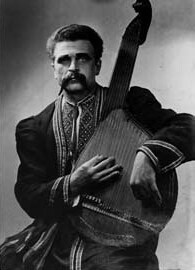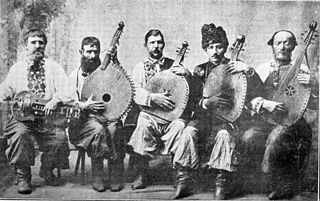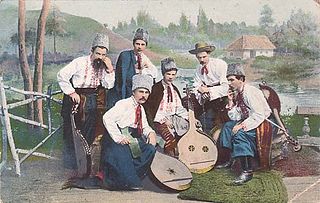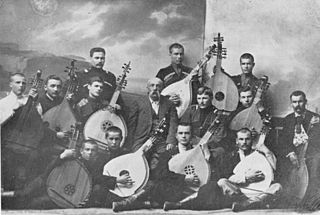
A bandura is a Ukrainian, plucked string, folk instrument. It combines elements of the zither and lute and, up until the 1940s, was also often referred to by the term kobza. Early instruments had 5 to 12 strings and similar to the lute. In the 20th century, the number of strings increased initially to 31 strings (1926), 56 strings - 68 strings on modern 'concert' instruments (1954).

A banduryst is a person who plays the Ukrainian plucked string instrument known as the bandura.

The kobzari of the Slobozhan bandura tradition were kobzari who lived in the Slobozhan region around the city of Kharkiv, Ukraine. They include Petro Drevchenko, Pavlo Hashchenko, Hnat Honcharenko, Horobetz, F. Hrytsenko-Kholodny, Hryhory Kozhushko, Ivan Kuchuhura Kucherenko, Ivan Netesa, Odnorih, Stepan Pasiuha, Mykola Ryhorenko and P. Trotchenko.
The Poltava Bandurist Capella was vocal-instrumental ensemble who accompanied themselves on the multi-stringed Ukrainian bandura. It was initially established in February 1925, based on a male church choir who sang in the Ukrainian Autocephalous Orthodox Cathedral in Poltava under the direction of Fedir (Khvedir) Popadych. The ensemble was disbanded in October 1934.
Kobzarskyi Tsekh - literally "Kobzar guild" - is an organization of kobzars, which existed from the 17th century in Ukraine.

The Kyiv Bandurist Capella is a male vocal-instrumental ensemble that accompanies its singing with the playing of the multi-stringed Ukrainian folk instrument known as the bandura.

The Ukrainian Bandurist Chorus is a semi-professional male choir which accompanies itself with the multi-stringed Ukrainian folk instrument known as the bandura. It traces its roots to Ukraine in 1918 and has been based in the USA since 1949.
The Prague Bandurist Capella was a musical ensemble formed in 1924 by Ukrainians living in Czechoslovakia featuring performers on the bandura.

Hryhory Ivanovych Bazhul was a Ukrainian bandurist and publisher of articles on bandura history from Poltava, Russian Empire. After World War II he emigrated to Australia settling in Sydney.

The Combined Kiev Bandurist Capella, also known as the Ukrainian State Exemplary Bandurist Capella, was a Ukrainian bandurist ensemble in the Soviet Union which existed from 1935 to 1941, until it was disbanded due to World War II.
Danylo Fedorovych Pika (1901–1941) was one of the founders of the Poltava Bandurist Capella. Initially he learned to play the bandura from Opanas Slastion in Myrhorod. Pika was one of the more talented players of the capella and also wrote out a number of interesting arrangements.

Mykhailo Stepanovych Kravchenko (1858-1917) was regarded as one of the most outstanding kobzars of Poltava province of the late 19th early 20th century.

Vasyl' Potapenko (1886–1934) born in Berezna, Mensk region, Chernihiv province was the guide-boy for the blind kobzar Tereshko Parkhomenko. As a guide-boy he was a participant of the ХІІth Archeological congress held in Kharkiv in 1902. He travelled to Halychyna by himself after discovering that Hnat Khotkevych had invited kobzars to perform there in 1909. When he discovered that the audiences in Halychyna had expected blind bandurists, he tried to blind himself by spraying caustic soda in his eyes. He returned to central Ukraine settling in Kiev where he made a living teaching bandura and re-selling banduras. Many of his students joined the Kiev Bandurist Capella in its second incarnation from 1924. He was a participant at the Xth historic-ethnographic concert held in Kiev in 1928. On October 15, 1930 Potapenko was arrested for being a member of "counter-revolutionary" (anti-Soviet) organizations. There were further arrests ending in his unexplained disappearance.
A Kuban bandurists is a person who plays the Ukrainian plucked string instrument known as the bandura, who is from Kuban, a geographic region of southern Russia surrounding the Kuban River.
The Honcharenko Brothers—Alexander (1913–2005) and Peter —became the dominant bandura-makers and designers in the Ukrainian diaspora.
The Leontovych Bandurist Capella was a male choir whose members accompanied themselves using a Ukrainian folk instrument known as a bandura. It was established in the displaced persons camps in Germany in 1946 and had an active performance schedule until 1949.
The Ukrainians in Kuban in southern Russia constitute a national minority. The region as a whole shares many linguistic, cultural and historic ties with Ukraine.
Kharkiv-style banduras are banduras that allow for the playing of the Kharkiv style, i.e. using the left hand to play melodic figures primarily over the side of the instrument as opposed to the Kiev style where the left hand primarily plays the basses. To allow for the added required dexterity of the left hand, the instrument is held parallel to the body of the player.















